Every stitch in a garment tells a story—and at the core of that story is the seam. Known in German as nahttypen, seam types are the structural foundation of all sewn items, from couture dresses to outdoor gear. These seams determine how fabric pieces come together, how strong they are, and how well they endure wear and washing.
Whether you’re a beginner sewing enthusiast or a seasoned fashion designer, knowing the different nahttypen will significantly improve the quality and functionality of your creations.
Why Nahttypen Matter in Garment Construction
The Function of Seam Types
Seams do more than just hold fabric in place. The choice of seam directly influences:
-
The garment’s durability
-
Its comfort level
-
How it handles stress and movement
-
Its visual aesthetics
Different fabrics and design goals require different nahttypen, making seam knowledge essential in both home sewing and mass production.
Most Commonly Used Nahttypen in Sewing
Let’s break down the most widely applied seam types, their characteristics, and where you’re likely to find them in garments.
1. Basic Seam (Einfache Naht)
This straightforward seam involves joining two fabric edges together with a single row of stitching. It is the most common and forms the base for more complex seam techniques.
Applications: Shirts, skirts, and basic clothing
Benefits: Easy to construct and ideal for beginners
2. French Seam (Französische Naht)
A favorite in delicate fabrics, the French seam hides raw edges within two layers of stitching, offering a polished, clean finish without a serger.
Applications: Lingerie, blouses, and sheer fabrics
Benefits: Professional appearance and no fraying
3. Flat-Felled Seam (Kappnaht)
Used where durability is crucial, the flat-felled seam is stitched twice and lies flat against the garment. It’s common in jeans and uniforms.
Applications: Denim wear, sportswear
Benefits: Strong, smooth, and long-lasting
4. Lapped Seam (Überlappte Naht)
This seam overlaps one piece of fabric over another and stitches them down. It works well with fabrics that don’t fray easily.
Applications: Leatherwork, felt garments
Benefits: Decorative and practical
5. Bound Seam (Gefaßte Naht)
Using bias tape or strips of fabric, this seam encloses raw edges for a finished look, often used in unlined jackets and luxury wear.
Applications: Jackets, dresses, bags
Benefits: Stylish and functional, prevents fraying
Advanced Nahttypen in Professional and Industrial Use
In commercial garment production, more specialized nahttypen are used for efficiency and performance:
-
Overlocked seams – Created with a serger for rapid construction and edge finishing
-
Double-needle seams – Found in T-shirts and stretch garments for durability
-
Taped seams – Used in waterproof clothing to prevent moisture penetration
These industrial seam types require specific machines but deliver superior results in large-scale manufacturing.
Choosing the Right Nahttypen for a Sewing Project
Factors to Consider
-
Fabric Characteristics – Thin fabrics do well with enclosed seams, while thick fabrics need stronger options
-
Garment Function – Sportswear needs flexibility; formalwear demands invisible seams
-
Skill Level – Some seams are beginner-friendly, others need more precision
-
Aesthetic Goals – Decorative seams enhance the visual appeal of garments
Selecting the right seam type not only makes sewing easier but ensures the garment performs as intended.
Essential Tools for Creating Clean and Durable Nahttypen
While a basic sewing machine can handle many seam types, some tools can help perfect the finish:
-
Serger (Overlock Machine) – For clean, professional edge finishing
-
Bias Tape Maker – Helps create bound seams
-
Seam Ripper – For fixing mistakes neatly
-
Pressing Tools – Iron, seam roll, and clapper for sharp, crisp seams
Using the right tools ensures your nahttypen are neat, strong, and comfortable.
Nahttypen and Garment Longevity
The right seam not only improves appearance but also extends a garment’s life. For example:
-
Flat-felled seams add reinforcement in high-stress areas
-
French seams reduce irritation in sensitive fabrics
-
Overlocked edges resist unraveling in frequently washed items
Better seams mean fewer repairs and longer-lasting clothes, which is a win for both consumers and the environment.
Eco-Friendly Sewing: Sustainable Practices with Nahttypen
As more designers adopt sustainable fashion practices, nahttypen have a role to play. Well-made seams reduce waste by:
-
Extending the wearability of garments
-
Reducing the need for frequent repairs
-
Enabling better recyclability of fabrics
Additionally, minimal seams can save on thread and energy consumption, contributing to greener garment production.
Mistakes to Avoid When Working with Nahttypen
-
Using the Wrong Seam for Fabric Type – Heavy fabrics need reinforced seams
-
Skipping Seam Finishing – Unfinished edges can unravel quickly
-
Inaccurate Seam Allowances – Leads to poor fit and shape issues
-
Poor Pressing Technique – Can make even strong seams look unprofessional
Avoiding these mistakes will help produce garments that look and feel store-bought.
Conclusion: Mastering Nahttypen Elevates Your Sewing Game
In sewing, the details matter—and seams are one of the most vital details. Mastering various nahttypen allows you to take your creations from amateur to expert. Whether you’re sewing for fashion, function, or fun, choosing the right seam ensures a polished, long-lasting garment.
From the classic plain seam to the professional flat-felled finish, there’s a nahttypen for every project. Learn them, practice them, and make them part of your design toolkit.

